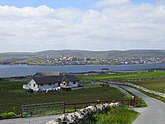Bressay
| Old Norsename | Breiðey/Brusey |
|---|---|
| Meaning of name | Old Norse for 'broad island' or 'Brusi's island' |
 Bressay Lighthouseat Kirkabister Ness overlooking Bressay Sound | |
| Location | |
| OS grid reference | HU507406 |
| Coordinates | 60°09′N1°05′W/ 60.15°N 1.08°W |
| Physical geography | |
| Island group | Shetland |
| Area | 2,805 ha (10+7⁄8sq mi) |
| Area rank | 30 [1] |
| Highest elevation | Ward of Bressay, 226 m (741 ft) |
| Administration | |
| Council area | Shetland Islands |
| Country | Scotland |
| Sovereign state | United Kingdom |
| Demographics | |
| Population | 368[2] |
| Population rank | 25 [1] |
| Population density | 13/km2(34/sq mi)[2][3] |
| Largest settlement | Maryfield |
| References | [3][4][5] |
Bressayis a populated island in theShetlandarchipelago of Scotland.
Geography and geology
[edit]Bressay lies due south ofWhalsay,west of theIsle of Noss,and north ofMousa.With an area of 11 square miles (28 km2), it is the fifth-largest island in Shetland. The population is around 360 people,[2]concentrated in the middle of the west coast, around Glebe and Fullaburn.
The island is made up ofOld Red Sandstonewith some basaltic intrusions. Bressay was quarried extensively for building materials, used all over Shetland, especially in nearbyLerwick.[3]There are a number of sea caves and arches. The largest of eleven lochs on the island are the Loch of Grimsetter in the east, and the Loch of Brough.
Wildlife
[edit]Bressay has a large number of migrant birds, especially in the east. The Loch of Grimsetter is a haven forwadersandwhooper swans.In the far south, there is a colony ofArctic skuas.[3]The southern half of the island has been identified as anImportant Bird Area(IBA) byBirdLife International.[6]
History
[edit]The name of the island may have been recorded in 1263 as 'Breiðoy' (Old Norse"broad island" ). In a 1490 document the island is referred to as "Brwsøy" - "Brusi's island" which name may indicate it was the 11th century base forEarl of OrkneyBrusi Sigurdsson.[7][3]This possibility is supported by a later reference to his sonRögnvaldas "Lord of the Shetlanders" and Thompson (2008) is in "no doubt" that Shetland specifically was in Brusi's possession during his joint earldom with his brothers.[8][9]
TheBressay Stoneis an outstanding example ofPictish art.
- a slab ofchloriteslate,about 16 inches [400 mm] wide at the top, tapering to less than a foot [300 mm] at the bottom.[5]
The slender sides are engraved withogham,and the two faces with various examples of knotwork, and imagery. The top of each face has a cross. On one side, there is an engraving of two men withcrosiers,as well as various animals including horses, pigs, and what appears to be someone in the process of being swallowed by twosea monsters.It has been suggested that this isJonah.[5]
DuringWorld War IandIIgun emplacements were built to guardBressay Sound.
Infrastructure
[edit]Attractions on the island includeBressay Lighthouse.At Maryfield there is aheritage centre,a hotel and the oldlaird's mansion,Gardie House,built in 1724.[10][11]
Frequentcar ferriessail from Maryfield toLerwickon theShetland Mainland.During the summer months, a passenger ferry service links the east coast of Bressay with thenature reserveIsle of Noss.
Lerwick and Bressay Parish Church(of theChurch of Scotland) has three places of worship. The Bressay Church building is located close to the Marina, near the centre of the west coast of the island.
Gallery
[edit]- Images of Bressay
-
Full-rigged shipMaella,ofOslo,in Bressay Sound circa 1922
-
Cross-bedding in MiddleOld Red Sandstoneon Bressay
-
Loch of Setter
-
View ofLerwickfrom Bressay
-
A replica of the Pictish Bressay Stone in St Mary's churchyard where the original stone was found.
See also
[edit]Notes
[edit]- ^abArea and population ranks: there arec. 300islands over 20 ha in extent and93 permanently inhabited islandswere listed in the2011 census.
- ^abcNational Records of Scotland(15 August 2013)."Appendix 2: Population and households on Scotland's Inhabited Islands"(PDF).Statistical Bulletin: 2011 Census: First Results on Population and Household Estimates for Scotland Release 1C (Part Two)(PDF)(Report). SG/2013/126.Retrieved14 August2020.
- ^abcdeHaswell-Smith (2004),pp. 425–429
- ^Ordnance Survey.OS Maps Online(Map). 1:25,000. Leisure.
- ^abcAnderson, Joseph (Ed.) (1893)Orkneyinga Saga.Translated by Jón A. Hjaltalin & Gilbert Goudie. Edinburgh.James ThinandMercat Press(1990 reprint).ISBN0-901824-25-9
- ^"South Bressay".BirdLife Data Zone.BirdLife International. 2024.Retrieved1 September2024.
- ^Smith (1988),p. 27
- ^Smith (1988),p. 21
- ^Thomson (2008),pp. 70–73
- ^"bressay".Visit Shetland.Retrieved1 March2013.
- ^Visit Scotland - Northern Lights Spa HotelArchived2011-07-18 at theWayback MachineRetrieved 30 June 2007.
References
[edit]- Haswell-Smith, Hamish (2004).The Scottish Islands.Edinburgh: Canongate.ISBN978-1-84195-454-7.
- Smith, Brian (1988), "Shetland in Saga-Time: Re-reading the Orkneyinga Saga",Northern Studies,25,Edinburgh: Scottish Society for Northern Studies: 21–41
- Thomson, William P. L. (2008),The New History of Orkney,Edinburgh: Birlinn,ISBN978-1-84158-696-0
External links
[edit]- Cullingsbrough,bressay-history-group.org. Archived on March 2, 2012.
- Cullingsburgh (Culbinsburgh, Culbinsgarth),geos.ed.ac.uk.
- Papil Geo, Isle of Noss, Bressay,paparproject.org.uk







